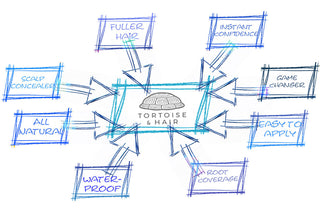Androgenetic Alopecia, commonly referred to as male or female pattern baldness, is the most prevalent form of hair loss worldwide. It affects approximately 50 million men and 30 million women in the United States alone. This hereditary condition causes progressive thinning of hair due to the miniaturization of hair follicles, primarily influenced by genetic and hormonal factors. While it is most noticeable in men as a receding hairline or thinning crown, it manifests differently in women, typically appearing as diffuse thinning across the scalp without a noticeable receding hairline.
This condition often begins in early adulthood but becomes more prominent with age. By the time men reach their 50s, more than 50% will experience some degree of Androgenetic Alopecia. Among postmenopausal women, the prevalence rises significantly, highlighting the influence of hormonal changes on its progression.
What Are the Symptoms?
The hallmark symptoms of Androgenetic Alopecia differ between men and women due to distinct patterns of hair loss.
In men, the condition often starts with a receding hairline at the temples, followed by thinning at the crown. Over time, these areas may merge, leaving a ring of hair along the sides and back of the scalp. This pattern is often referred to as the "horseshoe shape." The progression varies, with some men experiencing slow thinning over decades and others seeing more rapid hair loss.
Women, on the other hand, typically experience a diffuse thinning across the scalp, with the part line becoming wider over time. Unlike men, women rarely develop complete baldness. However, the hair’s overall density decreases, leading to visible scalp areas. This type of thinning often begins during or after menopause, correlating with hormonal shifts.
Can It Be Treated Medically?
While Androgenetic Alopecia cannot be cured, various treatments can slow its progression or encourage regrowth in affected areas. The effectiveness of these treatments often depends on early intervention and individual response.
- Minoxidil: Approved by the FDA for both men and women, this topical solution is applied directly to the scalp. It works by increasing blood flow to hair follicles, potentially stimulating regrowth and slowing further loss.
- Finasteride: An oral medication prescribed primarily for men, finasteride inhibits the conversion of testosterone to dihydrotestosterone (DHT), the hormone responsible for follicular miniaturization. Women, especially those of childbearing age, are usually not prescribed this medication due to potential side effects.
- Low-Level Laser Therapy (LLLT): Devices such as laser combs or caps emit low-level light to stimulate hair follicles, promoting thicker and healthier hair growth.
- Hair Transplants: For individuals seeking a more permanent solution, hair transplantation involves relocating healthy hair follicles from the back or sides of the scalp to thinning or balding areas.
These treatments require consistency and patience, as visible results often take several months to become apparent. Early detection and action are crucial for maximizing their effectiveness.
What Are Options to Help My Thinning Hair Caused by Androgenetic Alopecia?
For those managing the cosmetic effects of Androgenetic Alopecia, several practical options can help restore confidence and create the appearance of fuller, thicker hair.
Hair fibers, like those offered by Tortoise & Hair, are an excellent choice for concealing thinning areas. These fibers cling to existing hair, instantly improving its density and creating a natural look. They are especially effective for mild to moderate hair loss and are easy to apply daily.
Wigs and extensions provide a versatile solution for individuals with more advanced thinning or balding. Wigs offer a complete transformation, allowing you to experiment with styles, textures, and colors. Extensions can add volume to thinning areas without requiring long-term commitment.
Strategic haircuts can also make a significant difference in masking thinning areas. Styles that add layers or volume can create the illusion of thicker hair. Women often find that adding bangs or opting for shorter cuts can draw attention away from thinning sections.
For those ready to embrace their hair loss, shaving the head can be a bold and empowering move. Many men find that owning their look with confidence shifts the narrative from loss to personal strength and self-expression.
Moving Forward with Confidence
Androgenetic Alopecia may alter your appearance, but it does not define your identity. Whether you choose medical treatments, cosmetic solutions like hair fibers, or simply embrace your natural look, the goal is to feel confident in your own skin. At Tortoise & Hair, we’re here to support you with products designed to help you reclaim your style and confidence, one day at a time.



